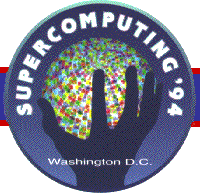 November 1994
November 1994
IEEE/ACM Supercomputing
 November 1994
November 1994
IEEE/ACM Supercomputing
Our first formal public demonstration of PAPERS was at the IEEE/ACM Supercomputing conference in November 1994.
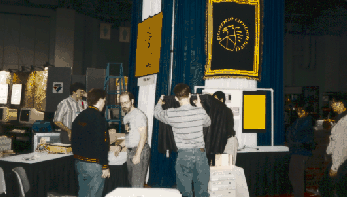
Although none of us had previously arranged a formal research exhibit at a conference, we decided to apply for research exhibit space at Supercomputing to demonstrate several PAPERS clusters. Much to our surprise, we were awarded Research Booth R4, a full 20' by 20' space located next to the sign that introduced the research area of the exhibit floor. Prime real estate and a lot of it. After much perseveration (and several manufacturers breaking their promises of loaner machines and/or donations), we finally settled on showing the following four clusters.
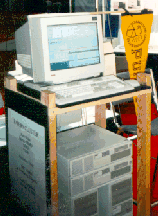 Four DEC Alphas running OSF.
Four DEC Alphas running OSF.
These machines were two 166MHz and two 233MHz units, all provided to
us by DEC as loaners for the show. These machines were truly state of
the art; the 233MHz machines were only announced a week before
Supercomputing. Unfortunately, we only had them for two weeks before
the show, and it wasn't easy to get OSF to let us directly access the
parallel port. Just in time, we were able to get direct port access
by compiling some of our code into the OSF kernel. TTL_PAPERS was
used to connect the machines for the demonstrations, which were
benchmarks of the PAPERS C library support routines (interactively
selected from a TCL/TK menu). The 233MHz boxes are standing upright
with the 166MHz ones horizontally on top of them, the TTL_PAPERS box
is barely noticable sitting to the right of the montor.
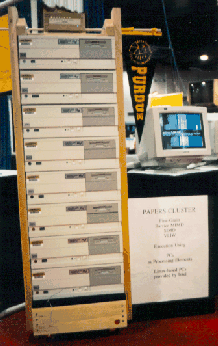 Eight Intel 386 running Linux
Eight Intel 386 running Linux
Unlike the DEC machines, these 386DX 33MHz systems were not exactly
state of the art; in fact, they were essentially discarded when Intel
upgraded one of our undergraduate labs to 486DX2 66MHz machines.
However, each of the 386 boxes has floating point hardware which we
have measured at about 4MFLOPS, so it isn't quite as bad as it first
sounds. The same is true of the $30 homemade wooden "rack mount" --
which recieved almost as much praise as our research work did. This
cluster was connected using an 8-processor version of PAPERS that is
similar to the November 1994 TTL_PAPERS, but essentially doubles the
communication bandwidth. The monitor on the right was displaying
continuous benchmark results for the complete PAPERS C library,
showing both the time and variation in time for each operation.
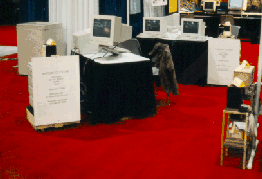 Two Four-Machine IBM Clusters
Two Four-Machine IBM Clusters
The last two clusters demonstrated in our booth consisted of four
machines each: a cluster of Four IBM PowerPC 601 80MHz running
AIX to the left, and a cluster of Four IBM ValuePoint
486DX 33MHz running Linux to the right (the plant-stand on
the near right held a display of the evolution of PAPERS through the
first six prototypes). The PowerPC machines didn't perform very well
and the parallel port access was very slow because we had to use an OS
call, but these machines were pre-release prototypes given to us as
loaners.... We connected them using one of the TTL_PAPERS units, and
ran a very simple demonstration showing barrier synchronization time
and variation in time. On the other hand, the ValuePoint machines are
very "normal" 486 systems, and we took advantage of this by actually
having two different versions of PAPERS simultaneously connecting the
cluster, with a wide range of demonstrations available for each unit
(partly because this was the cluster we demonstrated at ICPP).
Despite this, most of the time we simply had the ValuePoint cluster
run a SPMD program that plays multivoice music by assigning each new
note to be played by a randomly selected machine -- using PAPERS to
ensure that timing of the notes is preserved.
The next public demonstration of PAPERS at a conference was August 1995 at the international workshop on Languages and Compilers for Parallel Computing.